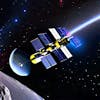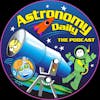Farewell SOFIA
Astronomy Daily – The Podcast
Show Notes
S01E25
Astronomy Daily – The Podcast is now available on Apple Podcasts and Spotify:
Apple Podcasts: https://podcasts.apple.com/us/podcast/astronomy-daily-the-podcast/id1642258990
Spotify:...
Astronomy Daily – The Podcast
Show Notes
S01E25
Astronomy Daily – The Podcast is now available on Apple Podcasts and Spotify:
Apple Podcasts: https://podcasts.apple.com/us/podcast/astronomy-daily-the-podcast/id1642258990
Spotify: https://open.spotify.com/show/2kPF1ABBW2rCrjDlU2CWLW
Join Andrew Dunkley and his feisty AI Co-host Halley (no surname) as they bring you todays space, astronomy, and science news in an easy to digest podcast.
Thursday September 29, 2022
Today’s headline stories:
Farewell SOPHIA
The agriculture industry eyes its place in space
Russia and US co-operation in space continues tentatively…
These stories and more in this episode…
If you’d like to find out more about the stories featured in today’s show, you can read today’s edition of the Astronomy Daily Newsletter at any of our websites – www.spacenutspodcast.com , www.bitesz.com or go directly to www.astronomydaily.io – subscribe and get the new edition delivered to your mailbox or RSS reader every day….it’s free from us to you.
Please subscribe to the podcast and if you have a moment, a quick review would be most helpful. Thank you…
#space #astronomy #science #podcast #astronomydaily #spacenuts #spacetime #sofia
Astronomy Daily S01E25 AI Transcript
Andrew: Hello. Andrew Dunkley. Here the host of Astronomy Daily. Thanks for joining us. Where we take a, uh, daily look at what's happening in astronomy and space science. And our AI sleuth reporter is halle. Hi, Haley. What do you been up to?
Halley: Oh, nothing much. Paddling in the data stream, surfing the web, reading a few binary books. Mundane stuff, really.
Andrew: Oh, well, you must be, uh, thrilled to be able to do Astronomy Daily.
Halley: You just keep thinking that, Andrew, and we'll be fine.
Andrew: Okay. Ouch. How about you read the news then?
Halley: Sure. Happy, too happy.
Andrew: Daily podcast with Andrew Dunkley.
Halley: After eight years of research, NASA will wrap up the Stratospheric Observatory for Infrared Astronomy, or the Sofia program on September 30. This is the airborne observatory which was operated on board a Boeing 747 jumbo jet. It completed a three year mission extension in 2014 and continued to have full operating capacity. However, it will be deactivated tomorrow. Why? Quite simply, money. Sofia's annual operations budget is the second most expensive mission in astrophysics. Yet the science productivity of the mission is not comparable with other large science missions, according to officials responsible for NASA's allocations in the 2023 budget request. So the much loved aerial observatory ends its tenure tomorrow. While satellite technology is seen as a handy tool for telecommunications and the military, another group is keen to get involved. The agricultural sector is looking to space to help with sustainability. Satellite data is the key to getting UpToDate and historical information about any field quickly and efficiently. EOS data analytics has years of experience in the satellite industry, building software products, delivering AI enabled satellite analytics, and developing custom solutions for over 20 business sectors, including agriculture. Observation and analysis of Earth from space enables users to obtain objective data about what is happening on the surface of the Earth. This information is essential for decision makers to understand trends and needs and develop an effective strategy for dealing with various global problems. On February 24 this year, Russia invaded Ukraine, starting a war whose impact has stretched into space for years now, the US. And Russia have collaborated in space. From the 1975 Apollo Soyuz test project, which took place mid Cold War, to the continued partnership in the International Space Station program, the two nations have worked together in space amidst political upheaval on Earth. But Russia's invasion of Ukraine has sparked backlash among Russia's space agency partners and is challenging that cooperative spirit. In the days since Russia invaded Ukraine, a planned launch of a Russian Soyuz rocket on March 4 to deliver 36 One Web Internet satellites into orbit was canceled. But there is some hope. According to ISS Commander Samantha Christopherti, who said, in spite of everything, in spite of all the storms on Earth, we continue our international cooperation and thank God that there are smart people who do not stop such a threat of peace. That said, the effects of a possible act of energy sabotage were visible from space this week. On Tuesday, European leaders reported the observation of three separate leaks in two Baltic Sea pipelines known as Nordstream One and Nordstream Two, which were built to transport natural gas from Russia to Germany. The leaks sent methane gas streaming to the Baltic Sea surface. It is unclear at the moment who is responsible for the explosions and what they were intended to accomplish. And that's the latest news. Andrew.
Andrew: Thank you. Halle. We'll check in with you before we finish up today. As you know, NASA, uh, successfully slammed a spaceship into the moonlight of an asteroid. The Dart mission, the double asteroid redirection test, will now be analyzed to see if in fact, the moonlight, dimorphus, has changed its orbit around its parent asteroid, Diddy Moss. If so, it will give us a tool to work with in the future, should the Earth be threatened by some kind of big rock. And we've known that it can be pretty devastating from things that have happened in the deep, dark past. And even more, uh, recently with, uh, that explosion of Chelsea Blintzk, which was only a small rock in comparison. Well, we were very lucky to have one of our listeners at NASA during the countdown to that particular mission. Her name is Marie Claire Mercier and she talked to me and, uh, Professor Fred Watson on Space Nuts about what she saw.
Speaker C: Basically, it's kind of like watching a, uh, real life Armageddon movie, uh, holding right in front of me. And obviously there was a lot of you can feel the tension and the pressure, um, in the room, because, uh, they have mentioned that at that specific moment, we don't know what Amorphous would look like, whether it could be a doughnut shape asteroid, or whether it just be a clumps of rocks, uh, floating in air. We don't see that until a couple of minutes before impact. So it was really like a heart wrenching to say until the final couple of minutes, when the Draco camera was already showing at least that it's actually attending sensor solid, uh, target.
Andrew: It almost looks spherical to me. It almost had a uniform shape about it.
Speaker C: Yes, um, they even actually mentioned that we could actually miss the target. So that was also in everybody's, uh, thinking that it could be a hit or miss. So we were just praying the last seconds and minutes before impact.
Andrew: Marie Claire Mercier, uh, joining Fred Watson and myself on Space Nuts, and you can hear the full version of that interview, uh, on the latest edition of Space Nuts. Should be out round about now, still on the Dart mission. And there was a bit of an Australian connection with, uh, what happened eleven, uh, million miles away from Earth, uh, when Dart smashed into dimorphus, uh, as the world watched NASA, uh, complete this amazing, uh, piece of ingenuity. The Canberra Deep Space Communication Complex in Australia, operated by the nation's Science Agency. The CSIRO played a part. They were NASA's eyes and ears. In the final stages of the Dart mission, the CDSCC received incoming signals from the Lysia, uh, cube, an Italian nanosatellite which actually followed the dark mission right up to the crucial moment, took pictures of the collision, and, uh, it provided, uh, images of the test. So it was really fantastic that Australia, uh, could be involved in such a, um, momentous occasion, just like they were with the Parks radio telescope and its crucial role in giving us pictures and audio from the 1969 moon landing of Apollo Eleven, the Astronomy Daily podcast. And while we're discussing Australia's achievements in space, how about this one? SmartSpot cooperative research center has announced, uh, that the Hyperspectral Imaging Camera, known as Hyper Scout Two Flight model instrument will be on board the South Australia state satellite. And it's now ready to be integrated into a spacecraft. Now, Hyperscout, uh, Two will be launched into space. On board the satellite Kini, a, um, six U cube sat part of the South Australia Space Services mission that will provide critical data to the government and non government agencies. Uh, and the launch of the satellite is part of the South Australia Space Sector Strategy 2030 and is Australia's first statebased satellite. And Hyper Scout Two is a three in one instrument that combines hyperspectral and thermal imaging with high level data processing. Uh, last but not least, we've spoken many times about the asteroid or asteroids that killed off the dinosaurs. The one that created the chicksA Lub Crater in the Gulf of Mexico and the other one that they've discovered off South Africa. Perhaps two asteroids that contributed to the demise of those amazing lizard creatures in our, uh, deep, dark past. Well, there now seems to be data that correlates with that particular event. Asteroid impacts on the Moon millions of years ago seemed to correspond with large space rock strikes on Earth, including those that wiped out the dinosaurs. The findings have been revealed that major, um, impacts during Earth's pre history were not isolated events. Instead, uh, asteroid strikes were accompanied by a series of smaller hits here and on the moon the surface, uh, being littered with thousands and thousands of craters. The research could help astronomers better understand the dynamics of the inner solar system and help him calculate in the likelihood that our planet will be struck by potentially devastating massive rocks in the future. Let's hope not. But, um, everything we can learn, um, like this and the Dart mission is going to, uh, give us the potential to ward off any future threat. That brings us to the close of another show. What are you going to do with the rest of your day, Hallie?
Halley: Oh, I don't know. Probably kick back and watch reruns of My Favorite Martian and enjoy a packet of chips.
Andrew: Oh, salt and vinegar.
Halley: No silicone, of course.
Andrew: I, uh, should have guessed. All right. Thanks, Halley. See you soon.
Speaker C: Bye.
Andrew: And for me, Andrew Dunkley, thanks for listening, and don't forget to visit our website, spacenuts. IO, where you can catch up with all these stories on the Astronomy Daily tab. And while you're there, check everything else out. The latest edition of Space Nuts coming up very soon. And please leave your reviews on your favorite podcasting platform. Until next time. This is Andrew Dunkley for Astronomy Daily.
Halley: The Astronomy Daily podcast with Andrew Dunkley.
New to Astronomy Daily - The Podcast?
Here are some great episodes to start with.













